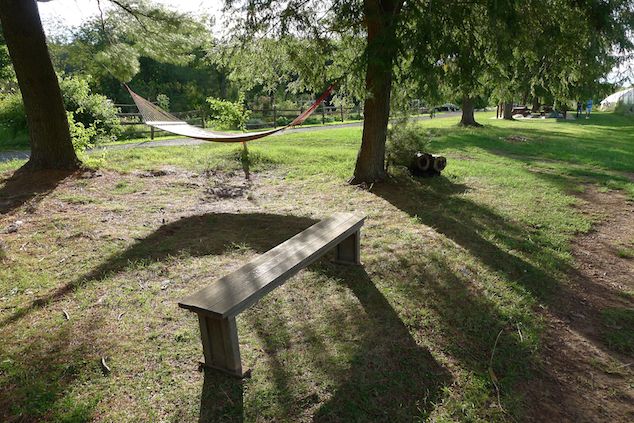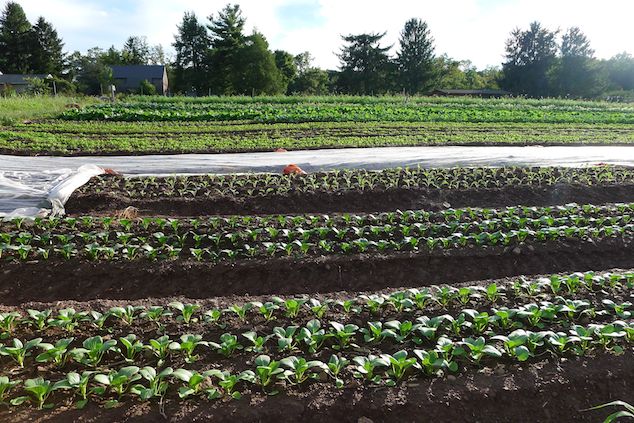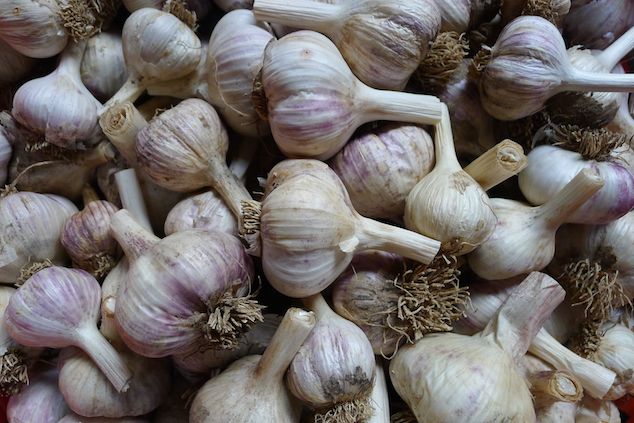
Eleven years of preservation on Anchor Run Farm

Anchor Run Farm hammock lonely in its emptiness but happy for the sunshine.

Fall greens like bok choy, arugula, and lettuce and fall roots/stems like kohlrabi, fennel, and radishes are enjoying the nice weather.
News
Notes From The Field
Fall and Spring Prepping
By Derek McGeehan
Fall and Spring Prepping
By Derek McGeehan
Yesterday we enjoyed a nice, slow, soaking rain amounting to four tenths of an inch and today we woke up to temperatures in the 40s. Perfect weather for the broccoli and cabbage that are heading up as well as a good way to hopefully slow down the super prolific Swiss chard and kale that we seem to not be able to keep up with. Who can complain about that, though? Fields are slowly emptying themselves of their cash crops and are starting to bed down for the winter.

Cured for long-term storage and shelf-stability, Anchor Run garlic has been saved and replanted for 11 years, making a unique variety.
Potatoes are out of the ground, cherry tomatoes are finished, the last of the green tomatoes were harvested, and our first planting of eggplant is retired. Some of those areas have already been chisel-plowed and now await the next step, most likely raised beds with a winter killed cover crop in anticipation of spring planting 6 months from now. This year we're really trying to connect and bridge the seasons with our thought processes and physical work through appropriate tractor work in the fall that will save us time, preserve soil structure, and help us out in the spring. This means being more conservative with cover crops, which is a totally different way of thinking for us. Typically we try to cover as much of the farm as possible with cover crops, which is a good thing to do except when it results in increased tillage the following spring, which could damage the soil, undo the benefits of those cover crops, and use up much needed time and energy. Now that we can safely fallow about a third of the farm every year and rotate the fallow areas around, we can rely on that time for much of the soil building properties of cover crops. The problem in the spring with conventional tillage is bringing cold, wet soil to the surface which is difficult to plant into and inhibits root growth. Hopefully by making raised beds in the fall and protecting them with a winter killed cover crop, we'll remove the need to chisel plow in the early spring and simply be able to "re-make" the raised beds. What we are able to do in the spring, plus the weather we receive then largely affects the rest of the season because we plant so much of the farm that time of year.

Expected Harvest
Departing Summer Veggies
By Derek McGeehan
Departing Summer Veggies
By Derek McGeehan
Harvest #17 (Week A) should include lettuce, kale, Swiss chard, winter squash, potatoes, leeks, garlic, hot peppers, sweet peppers, eggplant, tomatillos, and tomatoes. A few items could be a choice. U-pick should include basils, beans, dill, cilantro, perennial herbs, and flowers.

Registration open for 2014 Winter CSA, 2015 Main Season CSA
By Derek McGeehan
By Derek McGeehan
Registration for the 2014 Winter CSA and the 2015 Main Season CSA is available for current farm members on the Member's Page of our website. To sign up, simply log in and click on the 'Join' button on the right hand side of the page and follow the few steps. The Winter CSA is a 6-week (for now) season extension CSA with cold hardy greens such as arugula, greens mix, lettuces, chard, chicories, and kale; root crops like radishes, turnips, kohlrabi, rutabaga, and beets; as well as certain storage crops like garlic, winter squash, celeriac, and cabbage. Harvests are very similar to those at the end of the Main Season, and will begin following the final week of the 2014 Main Season, and will run through the last week of December. Pick ups are on Tuesdays from 1-8 PM. The 2015 Main Season CSA should once again last 26 weeks from May to November. Prices for the Main Season, the 12th CSA season, remain unchanged, but we have removed the $5 discount for making one payment instead of two due to some confusion during the sign up process. When you sign up, a $200 deposit or full payment is due to secure your membership. Registration for non-members will begin later in the fall, probably in December. E-mail us if you have any questions.

Fermenting Workshop - This Saturday
By Gia Yaccarino
By Gia Yaccarino
The next and final workshop for this growing season will be on Fermenting Basics from 11 AM - 1 PM on Saturday, September 20th. Derek and Dana will discuss fermented beverages, such as kombucha and kvass. Wayne and Cathy will demonstrate fermenting vegetables. Last year's presentation was incredibly informative! Please bring a small mason jar with you to the workshop, if you would like some "starter" to help you get started creating your own fermented beverages!

How did I enjoy my harvest this week?
By Linda Dansbury
By Linda Dansbury
Another week of strange weather - summer came back for a couple of days, and now temperatures are downright chilly. I don't know about you, but it does impact my decisions on what to cook. I do welcome the change of the seasons, but will miss, as always, the delicious taste of perfectly ripe, summer tomatoes. I still have some left in my garden, because I purposely plant them late, knowing that our farmers get tomatoes into the ground as early as possible. I mention this, because I know a lot of members out there also have gardens of their own as well. I do the same with my cucumbers - I know the farm's will come in early, so I plant mine late so they start to come in as the farm's are finishing up. Below is a snapshot of what I made this past week:
Swiss chard, tomatoes, onions - made the Swiss chard, Tomato and Gruyere Casserole that is on the website. It is rich and delicious. I had it for leftovers later in the week, with a poached egg on the top and a salad on the side.
Tomatillos, garlic, cilantro - made another batch of tomatillo sauce - I know I am getting redundant, but with all the other fresh veggies, it is difficult to use everything up some weeks, so the best way is to preserve some of it.
Kale - made Kale Chips one night to snack on while I was making the rest of my dinner. Tasty, satisfying and healthy.
Green Beans, sweet peppers, onions, oregano, parsley - made a string bean salad and had it with dinner one night and then for lunch with canned tuna for 2 more days.
Celery, onion, garlic, parsley - made braised celery. Most people think of celery as only for cutting up and eating with dip or peanut butter but it is delicious braised. If you have never tried it, please do so. Here is a recipe on our website that tops it with walnuts just before serving: Braised Celery.
Lettuce, tomatoes - made kind of a chopped salad using herbs for additional flavor and a balsamic dressing. Also sprinkled in some crumbled feta because I had it in fridge and didn't want it to go bad.

New items - they can be stored!
By Linda Dansbury
By Linda Dansbury
This time of year might be a bit overwhelming, especially if you are a new member. There are still a lot of summer crops coming in, but now potatoes, leeks, and winter squash are being harvested as well. Don't worry! Leeks will keep in the fridge in plastic bags for weeks. The potatoes we are receiving are storage potatoes. They are currently being stored at 60 degrees, which I have found in doing research is about the ideal temperature for storing potatoes and winter squash. So, find the coolest part of your home right now. It could be your basement; it could be a room near an air conditioning vent. This area is likely to change over the coming weeks, and you may need to move things around a bit as the weather changes. When temperatures are consistently cool (and looking at this week's forecast, that might be now), the garage may be a good place. Do not store in the refrigerator at his degrades the flavor very quickly. As for some other crops, here are my observations on how long things seem to stay fresh:
Beets - weeks, even a couple months in the fridge in plastic bags
Tomatillos - at least 2 weeks in the fridge. I typically make my tomatillo sauce using 2 weeks worth of tomatillos.
Eggplant - needs to be used within a week
Peppers - 2 weeks, but mine usually don't last that long.
Hot peppers - the same as sweet peppers
Garlic - the fresh lasts for up to a month in the fridge. Store the cured garlic, which we are now receiving, in a cool dry place - with your potatoes and winter squash, and it will keep for a few months.
Kale - will keep up to 2 weeks in a bag in fridge
Swiss chard - best when used within a week, but can keep a little longer
Lettuce - will vary by variety, but best texture and taste in the first week.
Tomatillos - at least 2 weeks in the fridge. I typically make my tomatillo sauce using 2 weeks worth of tomatillos.
Eggplant - needs to be used within a week
Peppers - 2 weeks, but mine usually don't last that long.
Hot peppers - the same as sweet peppers
Garlic - the fresh lasts for up to a month in the fridge. Store the cured garlic, which we are now receiving, in a cool dry place - with your potatoes and winter squash, and it will keep for a few months.
Kale - will keep up to 2 weeks in a bag in fridge
Swiss chard - best when used within a week, but can keep a little longer
Lettuce - will vary by variety, but best texture and taste in the first week.
As for using the winter squash, we have several recipes on the website. Please take a look but feel free to send me your recipes. I happen to love spaghetti squash and find that like "real" pasta, it is very flexible in how it can be finished. By this I mean it works equally well with a summery topping of a barely cooked tomato and basil sauce topped with pine nuts, or the Spaghetti Squash and Pork Stir Fry in which you can adjust the ingredients to your liking.


